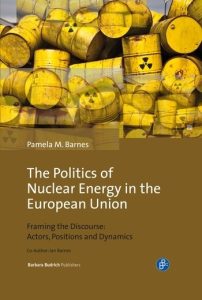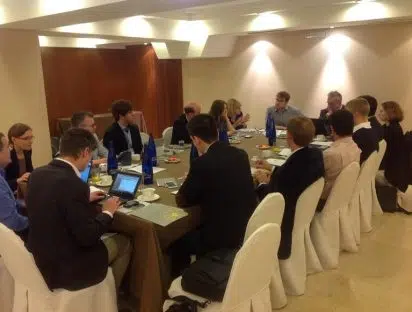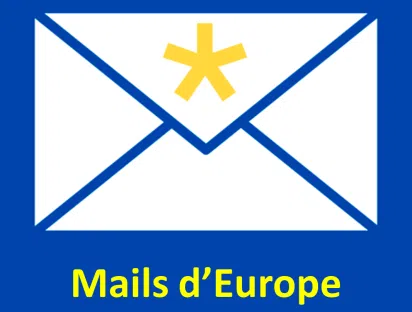
Read for more interesting information and insights our interview.
Prof. Barnes, what makes nuclear energy so interesting?
Researching developments in EU environmental and energy policies from the early 2000s I became increasingly aware that the EU’s evolving energy and climate strategy included the use of nuclear energy. But I was confronted by a riddle. How could something that seemed to have so much early promise have created so many controversies? The use of nuclear fusion technology to generate electricity in the European Union is arguably the most controversial of all the available electricity-generating technologies: nuclear energy deeply divides public opinion both within and between the EU’s member states. Some EU states evidence a long standing and deeply held opposition to the use of the technology [e.g. Austria, Denmark] whilst in others such as France, Hungary, Slovakia and the UK new plants are under construction.
Are there any countries that are of particular interest for you?
In the book I considered three EU’s states [France, German and the UK] that have used nuclear energy since the late 1950s and early 1960s. Each of these states has adopted a different approach to the inclusion of nuclear energy in its modern energy mix and I was interested to see why this had happened. In France, which is second only to the US as a producer and user of nuclear energy globally, a decision was taken in 2015 to cut back on the use of the technology from 75% of electricity generated to 50% by 2025, although more recent debates in the French government suggest the target year will rather be 2035. Germany’s energy transition programme the ‘Energiewende’ is based on twin objectives – to move from fossil fuels to a largely carbon free sector and at the same time to phase out nuclear generation of electricity by 2022. The UK government on the other hand has taken the decision to include nuclear generated electricity in a diversified national energy mix. It is of course easier to be a non-nuclear generating state if the country has an alternative energy resource or can afford to import fossil fuels as Germany continues to do.
Hailed as a solution to all energy problems in the 1950s, condemned after the Chernobyl accident in 1986. Is nuclear energy now having a comeback?
In the late 1990s/early 2000s the use of nuclear as an energy resource was portrayed by the European Commission as ‘a less than perfect energy option…’ linked as it was to military use of the technology. At that time, levels of support for the sector still suffered from the widespread devastation caused by the accident at the Chernobyl nuclear power plant in 1986. As the 2000s advanced, however, a number of factors combined to lend a new interest in nuclear energy in some states of the EU.
What does this comeback mean for the European institutions?
I began to question why this change had taken place and what the implications of the change might mean for the future of the nuclear energy sector in the European Union. Today, the peak periods of reactor development in the EU European states have clearly ended but this does not mean the demise of nuclear energy in the EU in the short to medium term. As a consequence the role of the European Institutions, in particular the role of the European Commission, to promote and ensure nuclear safety remains a crucial element of EU collaboration and co-operation. Structures have been developed within the EU on the basis of the sometimes over-looked 1957 European Atomic Energy Community Treaty [Euratom], but the competences conferred on the EU’s institutions by this Treaty continue to have value and as such should be maintained.
How is the comeback different from the early beginnings of nuclear energy?
The economic, political and social environments for the nuclear sector in the EU are very different in the twenty-first century from those of the mid twentieth century when European governments began to support the use of the technology to generate electricity. Then an optimistic view was taken on nuclear energy that the technology would provide a cheap volume base-load energy resource to meet increasing energy demand. But issues of safety, problems of de-commissioning and management of nuclear waste and costs soon became apparent. There has been no significant large reactor building programme since the 1990s in the EU, with many currently operating reactors being at risk of closure before the end of their operating licenses. Governments in Europe are increasingly cautious about the inclusion of nuclear energy in the national energy mix because of the massive amounts of investment capital needed for construction of new nuclear power stations. It is difficult to obtain this capital from the private sector and significant amounts of government support are needed for new developments. At the end of 2018 only 4 reactors were under construction in EU countries with major controversies surrounding a small number of planned developments.
Sounds like there is no future for nuclear energy in Europe?
This does not however signal the end of use of nuclear technology to generate electricity in the EU. The EU remains the most nuclearized region of the world, although China, India and Russia are building more reactors than the EU’s member states. The process of enlargement from 2004 to 2013 increased the number of EU member states where nuclear energy was generated and used. Enlargement of the EU also increased the challenges of EU energy dependency and the search for indigenous energy resources. Nuclear energy relies on small amounts of imported uranium and with the potential for re-processing nuclear energy could arguably be included as an indigenous resource. As such, nuclear energy has a role to play in providing energy security at a time of high-energy import dependency for the EU and increasing geopolitical tensions in parts of the world from which the EU obtains energy supplies.
Some even point out that nuclear energy might help to contain climate change?
The most important factor gathering support for continued use of the technology has been the questionable identification of nuclear energy as a sustainable, low carbon, and thus desirable, energy resource in the transition to a low carbon economy in Europe. Despite spectacular growth in the use of renewable technologies, green technologies are portrayed as incapable of reducing fossil fuel consumption in European countries in the short to medium term. Indeed in most policy scenarios the search for an environmentally and economically sustainable energy resource to replace fossil fuels includes consideration of nuclear generation of electricity.
What will be the role of nuclear energy in the European energy mix in the future?
The longer-term future for nuclear energy in the EU appears to be as a resource in an increasingly diversified energy mix as more use of renewable technologies is made. The outcome may bring a new dimension to the European nuclear sector with a focus on more limited electricity generation but with increased levels of employment in a range of varied technology developments associated with small modular reactors, fusion technology and the growth of de-commissioning and waste management programmes and facilities.
Which are the main drivers for the usage of nuclear energy in the future?
In any event using nuclear technology will be reliant on a combination of consensus in the political discourse and acceptance in the public discourse. It depends on the credibility of emerging storylines in the narrative that portray nuclear energy as capable of making a significant contribution to curbing greenhouse gas emissions and providing energy security, both of which are contested arguments. Public attitudes to the use of nuclear technology remain divided but re-framing the discourse in terms of the threat from climate change has brought with it an element of acceptance and some of those previously vehemently opposed to nuclear energy are ‘thinking again’. The discourse presents a ‘win-win’ situation from using nuclear electricity as it is depicted as a significant provider of volume base-load energy that limits greenhouse gas emissions and enables access to electricity at a stable price. But this political discourse would appear to have been captured by a narrative that represents ‘cynical idealism’ [global warming and environmental protection need the use of nuclear technology, irrespective of economic costs and public concerns] and pragmatic acceptance [energy demands may only be met by the use of nuclear technology], rather than unconditional and enthusiastic public support.
Thank you very much Prof. Barnes.

(Barbara Budrich Publishers; ISBN: 9783847406877; 292 Pages; Format: Hardcover; List Price: $66.00)
[cite]




